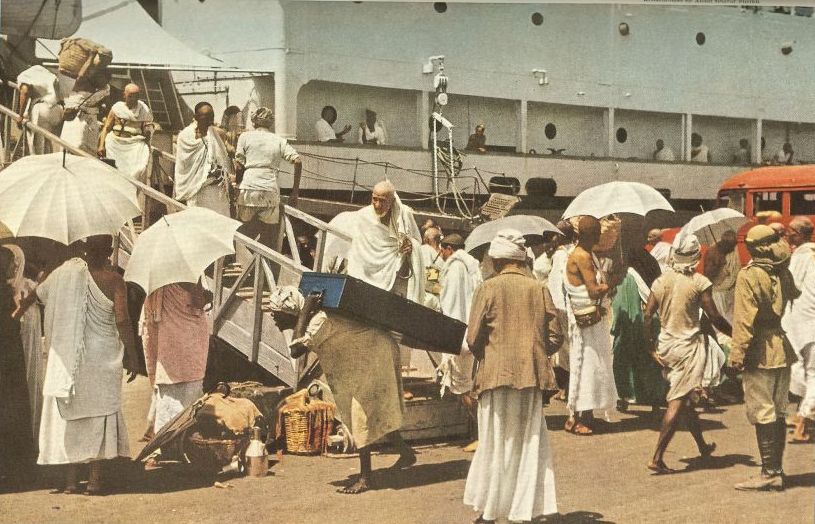The journey to Hajj has evolved dramatically over the centuries, transforming from harsh desert tracks to a well-organised global event.
The annual pilgrimage to Mecca, known as the Hajj, has been a timeless journey of faith for over 14 centuries. This integral rite, one of the five pillars of Islam, is a testament to the preservation of faith by Muslims worldwide.
Throughout history, the mode of transportation taken by pilgrims has been a dynamic variable, evolving in step with technological advancement and shifting landscapes.
This transformation, from harsh desert tracks to streamlined global travel, reflects not just the progress of technology, but also the lengths Muslims were happy to take for their faith.
Early period: the journey of peril
In the early Islamic period (7th-10th centuries), the pilgrimage to Mecca was a hard endeavor, often fraught with peril. The journey was often embarked on foot or on camels across harsh desert landscapes, sometimes taking months or even years.
Pilgrims would travel through the merciless heat of the day and chilling cold of the night, battling hunger, thirst, and threats from bandits.
Despite the challenges, these journeys fostered a sense of spiritual camaraderie that added to the profundity of the Hajj experience.
The spread of Islam and introduction of wheels
In the medieval era (11th-15th centuries), the pilgrimage landscape began to change, partly due to the rise of Islamic empires and the various administrations that sought to protect and facilitate the Hajj.
The Fatimids, Ayyubids, and later the Mamluks established safe routes, built rest houses, and provided water and food for pilgrims. The Hajj caravan became a well-established institution during this period, with large groups of pilgrims journeying together in relative safety and mutual support.
However, the journey was still long, and those who were looking to travel had to start their trip months earlier to be able to reach on time, if they reached at all.
Fast forward in the 15th-17th centuries, marine time technology during the age of exploration brought new ways of reaching Mecca.
Muslim travelers began using sea routes, sailing across the Red Sea or the Indian Ocean.
While it offered respite from the hardships of desert travel, sea voyages presented their own risks, including storms, shipwrecks and pirates. Nonetheless, it marked the beginning of a shift towards more accessible modes of travel for Muslims all over the world.
Modernity and the discovery of oil
Transportation underwent a significant change with the advent of modernity and the discovery of oil, introducing travelling methods that significantly cut travel time and made it much more safer for Muslims to reach Mecca.
The modern era (19th-20th centuries) in introduced transportation methods such as steamships and railways, further evolving the journey to Hajj.
The Suez Canal’s opening in 1869 cut travel time from South Asia and the Far East dramatically. Meanwhile, the Hejaz railway, completed in 1908, offered a convenient overland route for pilgrims from the Ottoman Empire’s territories.
However, it was still not an easy journey to embark on. In fact, the socio-political upheaval of the period, marked by colonial interference and World War I, disrupted the pilgrimage and the railway itself.
What we know today
The 20th century heralded an era of significant change, underpinned by advancements in aviation technology. Commercial air travel, which began in earnest in the 1970s, revolutionised the Hajj by making it possible for a broader demographic of the global Muslim population to undertake the pilgrimage.
The newly formed state of Saudi Arabia also embarked on massive infrastructure projects to accommodate the influx of pilgrims.
In the present day, the Hajj is a highly organised, large-scale event that sees millions of Muslims from around the world annually.
State-of-the-art technology, including advanced crowd management systems, mobile apps for pilgrims, and environmentally friendly transport solutions, are all transforming the experience.
Most Muslims opt for planes and trains as a way of transportation thanks to their efficiency and safety. However, some, mostly those who live in the Gulf area or Middle east, still choose cars and buses to reach Mecca for Hajj.
Whatever means of transportation pilgrims choose, it is still significantly safer than the earlier days thanks to the technological advancement and infrastructure development.
The evolution of the Hajj journey is a testament to the enduring significance of this Islamic rite and the adaptability of its practitioners.
From perilous desert crossings to the convenience of modern air travel, each stage of this evolution has been shaped by the changing contexts of the times, reflecting not just a physical and spiritual journey, but also a journey through Islamic history.
